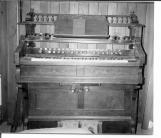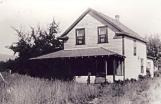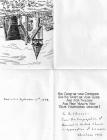14
Records were not kept of early bequests, with the exception of the picture of Crathie Church that was given to the congregation by Lady Aberdeen. This picture hung in the church throughout its use as a church. (Note: There is no record of where this picture is now. It may be with one of the families who looked after the church.) There were a number of other bequests over the years. These included: pump organ donated in 1914; silver christening bowl donated by Mrs. G. Boer in 1908; six chairs and Sunday School table from Mr. and Mrs. Hodgins in 1950; in 1952 a linen undercloth (acorn design) donated by the McMillan Circle; oak offering plates hand turned by Dr. and Mrs. Webb of North Battleford donated in 1949; red drapes from Mrs. Percy Mallett in 1957; Sunday School blackboard in 1955 from Mr. and Mrs. Doran; set of fine English China plates; and lastly noted was a flower basket presented by Mrs. Snowsell.15
Benvoulin United Church pump organ before it was restoredCirca 1980s
Benvoulin United Church, Benvoulin, British Columbia
 Credits:
Credits:Central Okanagan Heritage Society Fonds
16
Church linen with names of McMillan Circle members1940s-1950s
Benvoulin United Church, Benvoulin, British Columbia
 Credits:
Credits:Reid Family Collection (Allen Reid)
Lorri Dauncey (photographer)
17
Oak offering plates used at the Benvoulin United ChurchCirca 1940s
Benvoulin United Church, Benvoulin, British Columbia
 Credits:
Credits:Reid Family Collection (Allen Reid)
Lorri Dauncey (photographer)
18
China plate used for special occasions at Benvoulin United ChurchCirca 1900s
Benvoulin United Church, Benvoulin, British Columbia
 Credits:
Credits:Central Okanagan Heritage Society Fonds
Lorri Dauncey (photographer)
19
In June 1925, the congregation, without a dissenting vote, became part of the United Church of Canada. At that time all the office bearers resigned to clear the way for reorganization as a United Church congregation. The following trustees were elected: Alexander Reid, Archibald Hardy, Donald McEachern, William Hamill and Mrs. J. B. Fisher. Reverend Archibald McMillan took charge of the Rutland, Glenmore and Benvoulin churches at this time. Reverend McMillan served the United congregations with great success during these early difficult days of adjustment. His sermons produced by hours of fact-finding and bible study, were delivered with conviction, sometimes tempered with compassion. His sermons spoke from the heart. His compassion for those in need helped the three congregations through the hard times of the depression. Reverend McMillan planned to retire in 1937 after serving the three charges, but instead accepted the single charge of Naramata. He worked there until 1941, after which time he retired to live the rest of his days in the Okanagan Mission.20
Portrait of Reverend Archibald McMillanCirca 1930s
Benvoulin, British Columbia
 Credits:
Credits:Reid Family Collection (Allen Reid)
Benvoulin United Church Memory Book 1892-1952
21
There is little information on when the Manse, located at the back of the site, was built. The house may have been built with the intention that the ministers and their families live at the manse or possibly only as a place to stay when needed. The ministers, who served Benvoulin, also served Kelowna (until separated in 1912) and Rutland as well. As the ministers usually lived in Rutland, it is likely that the manse was usually rented out to local families.In 1930, the Johnson family moved to the Benvoulin church manse. Even though the family did not attend the church, they did look after the sweeping and dusting. There were other families who lived in the manse after the Johnsons, but little is known about these families. The manse was still standing when the church closed in 1964. The manse was rented out until it burned down sometime in the late 1960s.
22
Manse behind the Bethel Presbyterian Church/Benvoulin United ChurchCirca 1950s-60s
Benvoulin United Church, Benvoulin, British Columbia
 Credits:
Credits:Johnson Family Collection (Jeff, John, Henry Johnson)
23
Johnson family standing in front of the manse located behind Benvoulin United ChurchCirca 1934
Benvoulin United Church, Benvoulin, British Columbia
 Credits:
Credits:Johnson Family collection (Jeff, John, Henry Johnson)
Kelowna Public Archives #1393
24
Thank you card to Mr. H.H. Johnson for playing organ at Benvoulin United Church1952
Benvoulin United Church, Benvoulin, British Columbia
 Credits:
Credits:Johnson Family Collection (Jeff, John, Henry Johnson)
25
There have been a number of changes and modifications to the church since it was built. In 1932 the original cedar block church foundations were removed and new cement foundations were put in. Kaye (Peterman) Arthur remembers her father, Art Peterman helping to replace the church's old foundations and putting in the new cement foundations in 1932. They farmed land in the Benvoulin area, near Springfield and they were members of the Benvoulin Church in the late 1920s and early 1930s. Kay (Peterman) Arthur supplied an early photo of the church that she took just after the new foundations were put in, around 1934-35.26
Photograph of Benvoulin United Church using a pin-hole cameracirca 1935
Benvoulin United Church, Benvoulin, British Columbia
 Credits:
Credits:Central Okanagan Heritage Society Fonds
Kay (Peterman) Arthur (photographer)